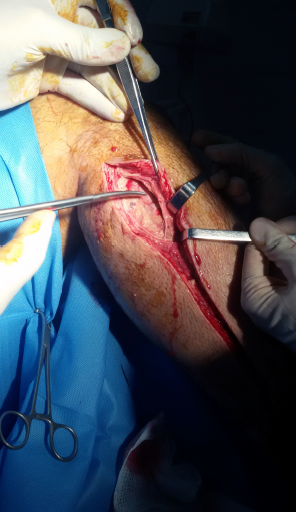Tips for Quickly Diagnosing Compartment Syndrome
After obtaining the intracompartmental pressure, you can use an absolute intracompartmental pressure of 30–40 mm Hg as diagnostic, but using a true intracompartmental pressure alone is problematic, as different compartments have varying pressure thresholds and patients may have varying absolute pressures.5,6,18,36 Some advocate using a perfusion pressure or differential pressure, which is calculated by subtracting the intracompartmental pressure from the diastolic pressure.4-6,19 A differential pressure (ΔP = compartmental pressure – diastolic blood pressure) of <20 mm Hg is diagnostic. While higher intracompartmental pressures can cause severe damage over a short time period, relatively lower but elevated intracompartmental pressures for long time periods can also cause severe tissue damage. Also, an absolute intracompartmental pressure >20 mm Hg in the setting of hypotension should be considered diagnostic.4-6,19,24 If the initial pressure is normal but the clinical picture fits compartment syndrome, a repeat measurement as well as pressure measurements in surrounding compartments are recommended.4-16,24 Table 3 shows situations that are diagnostic of compartment pressure.
Treatment

Figure 3: Lower leg fasciotomy
If you suspect compartment syndrome for any reason, emergently consult orthopedics. Once a motor nerve deficit is present, full recovery is rare.3,4,24 The orthopedic surgeon will most likely want to obtain their own pressure assessment, so the earlier you discuss the case with the surgeon, the better. If orthopedics is unavailable, discuss the case with a surgeon able to complete fasciotomy.
Definitive therapy is fasciotomy. In the emergency department, provide analgesia, resuscitate the patient, remove any constrictive dressings/bandages, reduce fractures, and elevate the affected extremity to heart level.3-5,17,26 Removing an external compressive device such as a tight cast can reduce pressure by up to 85 percent.5,6,38,39
Case Resolution
The patient has a firm lower leg with absent pulses. Passive movement of the foot causes extreme pain. Orthopedic surgery is consulted, and the patient is taken immediately to the operating room.
The views expressed in this publication do not reflect the views or opinions of the U.S. government, Department of Defense, U.S. Army, U.S. Air Force, Brooke Army Medical Center, or SAUSHEC EM Residency Program.
Dr. Long is an emergency physician in the San Antonio Uniformed Services Health Education Consortium at Fort Sam Houston, Texas.
 Dr. Koyfman (@EMHighAK) is assistant professor of emergency medicine at UT Southwestern Medical Center and an attending physician at Parkland Memorial Hospital in Dallas.
Dr. Koyfman (@EMHighAK) is assistant professor of emergency medicine at UT Southwestern Medical Center and an attending physician at Parkland Memorial Hospital in Dallas.
Take-Home Points
- History and exam findings in isolation have poor sensitivity, but in combination, their reliability improves.
- The go-to assessment is intracompartmental measurement.
- Treatment includes orthopedic consultation, analgesia, resuscitation, removal of external compression, and elevation of the affected extremity. Definitive treatment is fasciotomy.
References
- Marchesi M, Marchesi A, Calori GM, et al. A sneaky surgical emergency: acute compartment syndrome. Retrospective analysis of 66 closed claims, medico-legal pitfalls and damages evaluation. Injury. 2014;45(suppl 6):S16-20.
- McQueen MM, Gaston P, Court-Brown CM. Acute compartment syndrome. Who is at risk? J Bone Joint Surg Br. 2000;82(2):200-203.
- Donaldson J, Haddad B, Khan WS. The pathophysiology, diagnosis and current management of acute compartment syndrome. Open Orthop J. 2014;8:185-193.
- Duckworth AD, McQueen MM. The diagnosis of acute compartment syndrome: a critical analysis review. JBJS Rev. 2017;5(12):e1.
- Schmidt AH. Acute compartment syndrome. Orthop Clin North Am. 2016;47(3):517-525.
- Schmidt AH. Acute compartment syndrome. Injury. 2017;48(suppl 1):S22-S25.
- Mabvuure NT, Malahias M, Hindocha S, et al. Acute compartment syndrome of the limbs: current concepts and management. Open Orthop J. 2012;6:535-543.
- Mithöfer K, Lhowe DW, Vrahas MS, et al. Clinical spectrum of acute compartment syndrome of the thigh and its relation to associated injuries. Clin Orthop Relat Res. 2004;425:223-229.
- Finkelstein JA, Hunter GA, Hu RW. Lower limb compartment syndrome: course after delayed fasciotomy. J Trauma. 1996;40(3):342-344.
- Gourgiotis S, Villias C, Germano S, et al. Acute limb compartment syndrome: a review. J Surg Educ. 2007;64(3):178-186.
- Kalyani BS, Fisher BE, Roberts CS, et al. Compartment syndrome of the forearm: a systematic review. J Hand Surg Am. 2011;36(3):535-543.
- Vaillancourt C, Shrier I, Vandal A, et al. Acute compartment syndrome: how long before muscle necrosis occurs? CJEM. 2004;6(3):147-154.
- Mauser N, Gissel H, Henderson C, et al. Acute lower-leg compartment syndrome. Orthopedics. 2013;36(8):619-624.
- Al-Dadah OQ, Darrah C, Cooper A, et al. Continuous compartment pressure monitoring vs. clinical monitoring in tibial diaphyseal fractures. Injury. 2008;39(10):1204-1209.
- McQueen MM, Christie J, Court-Brown CM. Acute compartment syndrome in tibial diaphyseal fractures. J Bone Joint Surg Br. 1996;78(1):95-98.
- McQueen MM, Court-Brown CM. Compartment monitoring in tibial fractures. The pressure threshold for decompression. J Bone Joint Surg Br. 1996;78:99-104.
- Taylor RM, Sullivan MP, Mehta S. Acute compartment syndrome: obtaining diagnosis, providing treatment, and minimizing medicolegal risk. Curr Rev Musculoskelet Med. 2012;5(3):206-213.
- Via AG, Oliva F, Spoliti M, et al. Acute compartment syndrome. Muscles Ligaments Tendons J. 2015;5(1):18-22.
- Ulmer T. The clinical diagnosis of compartment syndrome of the lower leg: are clinical findings predictive of the disorder? J Orthop Trauma. 2002;16:572-577.
- Shadgan B, Pereira G, Menon M, et al. Risk factors for acute compartment syndrome of the leg associated with tibial diaphyseal fractures in adults. J Orthop Traumatol. 2015;16(3):185-192.
- McQueen MM, Duckworth AD, Aitken SA, et al. The estimated sensitivity and specificity of compartment pressure monitoring for acute compartment syndrome. J Bone Joint Surg Am. 2013;95(8):673-677.
- Wong JC, Vosbikian MM, Dwyer JM, et al. Accuracy of measurement of hand compartment pressures: a cadaveric study. J Hand Surg Am. 2015;40(4):701-706.
- Shuler FD, Dietz MJ. Physicians’ ability to manually detect isolated elevations in leg intracompartmental pressure. J Bone Joint Surg Am. 2010;92(2):361-367.
- McQueen MM. Acute compartment syndrome. In: Bucholz RW, Court-Brown CM, Heckman JD, Tornetta P III, eds. Rockwood and Green’s Fractures in Adults. 7th ed. Philadelphia: Lippincott Williams & Wilkins; 2010:689-708.
- Roberts CS, Gorczyca JT, Ring D, et al. Diagnosis and treatment of less common compartment syndromes of the upper and lower extremities: current evidence and best practices. Instr Course Lect. 2011;60:43-50.
- Raza H, Mahapatra A. Acute compartment syndrome in orthopedics: causes, diagnosis, and management. Adv Orthop. 2015;2015:543412.
- Tsai WH, Hunag ST, Liu WC. High risk of rhabdomyolysis and acute kidney injury after traumatic limb compartment syndrome. Ann Plast Surg. 2015;74(suppl 2):S158–S161.
- Lima RS, da Silva Junior GB, Liborio AB, et al. Acute kidney injury due to rhabdomyolysis. Saudi J Kidney Dis Transpl. 2008;19(5):721-729.
- McQueen MM, Duckworth AD, Aitken SA, et al. The estimated sensitivity and specificity of compartment pressure monitoring for acute compartment syndrome. J Bone Joint Surg Am. 2013;95(8):673-677.
- Large TM, Agel J, Holtzman DJ, et al. Interobserver variability in the measurement of lower leg compartment pressures. J Orthop Trauma. 2015;29(7):316-321.
- Boody AR, Wongworawat MD. Accuracy in the measurement of compartment pressures: a comparison of three commonly used devices. J Bone Joint Surg Am. 2005;87(11):2415-2422.
- Heckman MM, Whitesides TE Jr, Grewe SR, et al. Compartment pressure in association with closed tibial fractures. The relationship between tissue pressure, compartment, and the distance from the site of the fracture. J Bone Joint Surg Am. 1994;76(9):1285-1292.
- Matava MJ, Whitesides TE Jr, Seiler JG 3rd, et al. Determination of the compartment pressure threshold of muscle ischemia in a canine model. J Trauma. 1994;37(1):50-58.
- Saikia KC, Bhattacharya TD, Agarwala V. Anterior compartment pressure measurement in closed fractures of leg. Indian J Orthop. 2008;42(2):217-221.
- Harris IA, Kadir A, Donald G. Continuous compartment pressure monitoring for tibia fractures: does it influence outcome? J Trauma. 2006;60(6):1330-1335; discussion 1335.
- Mubarak SJ, Owen CA, Hargens AR, et al. Acute compartment syndromes: diagnosis and treatment with the aid of the wick catheter. J Bone Joint Surg Am. 1978;60(8):1091-1095.
- Sheridan GW, Matsen FA 3rd. Fasciotomy in the treatment of the acute compartment syndrome. J Bone Joint Surg Am. 1976;58(1):112-115.
- Mars M, Hadley GP. Raised compartmental pressure in children: a basis for management. Injury. 1998;29(3):183-185.
- Hoover TJ, Siefert JA. Soft tissue complications of orthopedic emergencies. Emerg Med Clin North Am. 2000;18(1):115-139.
Pages: 1 2 3 4 | Single Page
Topics: Compartment SyndromeCritical CareinfectionStryker monitor
Related
-
Navigating Strict State Abortion Laws
January 5, 2025 - 0 Comment -
Post-Tonsillectomy Hemorrhage: A Three-Pronged Approach
January 5, 2025 - 1 Comment -
The Latest Research in Neurologic Emergencies
September 6, 2024 - 0 Comment



3 Responses to “Tips for Quickly Diagnosing Compartment Syndrome”
November 19, 2019
Emil Pajek MDCannot find the CME that is listed in the article.
ALSO the article in the magazine has DIFFERENT Title than here …cannot find the CME /article or reference.
I had to call the ACEP
February 4, 2020
David GlassSame. I can’t find the CME link / test.
March 20, 2021
J WellsI think you mean AP is diastolic pressure minus compartment pressure